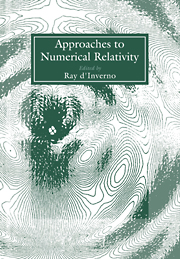Book contents
- Frontmatter
- Contents
- Contributors
- Introduction
- Preface
- PART A THEORETICAL APPROACHES
- Numerical relativity on a transputer array
- Some aspects of the characteristic initial value problem in numerical relativity
- The characteristic initial value problem in general relativity
- Algebraic approach to the characteristic initial value problem in general relativity
- On hyperboloidal hypersurfaces
- The initial value problem on null cones
- Introduction to dual-null dynamics
- On colliding plane wave space-times
- Boundary conditions for the momentum constraint
- On the choice of matter model in general relativity
- A mathematical approach to numerical relativity
- Making sense of the effects of rotation in general relativity
- Stability of charged boson stars and catastrophe theory
- PART B PRACTICAL APPROACHES
- PANEL DISCUSSION
Stability of charged boson stars and catastrophe theory
Published online by Cambridge University Press: 15 December 2009
- Frontmatter
- Contents
- Contributors
- Introduction
- Preface
- PART A THEORETICAL APPROACHES
- Numerical relativity on a transputer array
- Some aspects of the characteristic initial value problem in numerical relativity
- The characteristic initial value problem in general relativity
- Algebraic approach to the characteristic initial value problem in general relativity
- On hyperboloidal hypersurfaces
- The initial value problem on null cones
- Introduction to dual-null dynamics
- On colliding plane wave space-times
- Boundary conditions for the momentum constraint
- On the choice of matter model in general relativity
- A mathematical approach to numerical relativity
- Making sense of the effects of rotation in general relativity
- Stability of charged boson stars and catastrophe theory
- PART B PRACTICAL APPROACHES
- PANEL DISCUSSION
Summary
Abstract. We investigate the stability of charged boson stars in the framework of general relativity. The constituents of these stars are scalar bosons which interact not only via their charge and mass but also via a short–range Higgs potential U. Our stability analysis is based on catastrophe theory which is capable of providing more information than perturbation theory. In fact, it predicts novel oscillation and collapse regimes for a certain range of the particle number.
INTRODUCTION
In the early universe, spin-zero particles, such as the scalar Higgs particles, may have played an important rôle [1]. At that early time it is conceivable that clouds of particles created stars which are kept together by their own gravitational field, the so–called boson stars [2]. These stars could make up a considerable fraction of the hypothetical dark matter.
The boson star consists of many particles and may have a very large mass comparable or larger than that of a neutron star. The latter depends upon the form of a self–interaction between the bosons [3]. Generally speaking, the boson star is in many ways analogous to the neutron star [4,5]. Both stars consist of one matter component. Recently, Higgs particles interacting with gauge field have been studied [6]. If we attribute charge to the bosons, they will interact also via electromagnetic forces. Because of the repulsive nature of this interaction there exists a critical total charge of these scalar particles beyond which the star becomes unstable [6].
- Type
- Chapter
- Information
- Approaches to Numerical Relativity , pp. 130 - 140Publisher: Cambridge University PressPrint publication year: 1992
- 6
- Cited by



